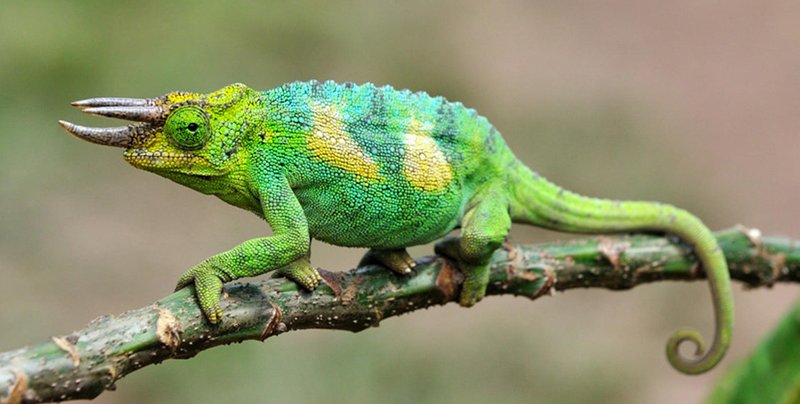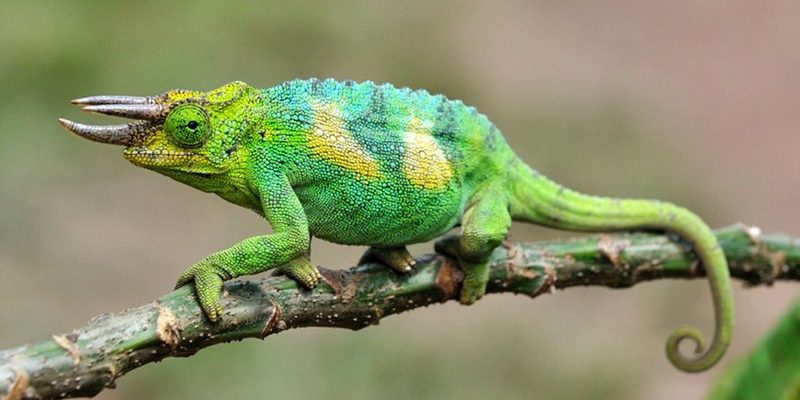
Let’s dive into what it means to care for a Jackson’s chameleon, the ups and downs of their care needs, and whether they could be the right fit for you. Like learning to ride a bike or bake a cake, keeping a chameleon requires some knowledge and practice—it’s not as simple as it might seem at first!
Understanding the Jackson’s Chameleon
The Jackson’s chameleon, known scientifically as *Chameleo jacksonii*, is a unique reptile that hails from the forests of East Africa. These chameleons are easily recognized by their three distinct horns on the males, giving them a rather prehistoric appearance. The females are typically less adorned but still carry their own charm with beautiful shades of green.
What’s truly captivating about these reptiles is their ability to change colors. This adaptation isn’t simply for camouflage; it also helps them communicate and regulate their body temperature. So, you might see a chameleon expressing itself by shifting from bright green when relaxed to darker shades when stressed. It’s like having a pet with a mood ring!
Understanding their natural habitat is essential. In the wild, these chameleons thrive in a humid, leafy environment. This means if you’re thinking of bringing one home, you’ll need to replicate these conditions to keep your new friend happy and healthy.
The Pros of Keeping a Jackson’s Chameleon
You might be wondering why anyone would want a Jackson’s chameleon as a pet. Here are some appealing reasons:
- Unique Appearance: Their striking colors and unusual shapes make them stand out. Let’s face it, how many of your friends have a chameleon?
- Low Maintenance: Compared to furry pets like dogs or cats, chameleons don’t need daily walks or grooming. They have their quirky needs but are generally low-key.
- Educational Opportunity: Keeping a chameleon can teach you a lot about reptiles and exotic pets. You’ll learn about their behaviors, diet, and habitats.
Even though they have some advantages, it’s essential to remember they require specialized care. You can’t just throw them in a tank and hope for the best. Understanding their needs is crucial for both their well-being and yours.
The Challenges of Caring for a Jackson’s Chameleon
On the flip side, owning a Jackson’s chameleon isn’t without its challenges. Here’s what you should consider before jumping in:
- Specific Environmental Needs: Chameleons require specific humidity and temperature levels. You’ll need to invest in a suitable terrarium and monitoring equipment.
- Dietary Requirements: They thrive on a diet of live insects, such as crickets and mealworms. If you’re squeamish about bugs, this might be a dealbreaker.
- Stress Sensitivity: These creatures are sensitive to their environment and can easily become stressed by sudden changes or mishandling. You’ll need a bit of patience to bond with them.
Each of these factors requires careful consideration. If you’re not ready to meet their unique needs, a Jackson’s chameleon might not be the best beginner pet.
Housing Requirements for Jackson’s Chameleons
Creating a suitable habitat for your Jackson’s chameleon is crucial. Here’s what you need to consider:
1. Terrarium Size: An adult Jackson’s chameleon needs a spacious terrarium—ideally, a minimum of 24 inches tall and 16 inches wide. They love to climb, so vertical space is essential.
2. Humidity & Temperature: Maintain a humidity level of around 50-70%, and a temperature gradient of 75°F to 85°F during the day, dropping to about 60°F at night. You’ll likely need a heat lamp and a hygrometer to keep tabs on the conditions.
3. Plants & Decor: Provide live plants like pothos or ficus, which not only offer hiding places but help maintain humidity. A good setup mimics their natural environment, which helps your chameleon feel secure.
4. Lighting Needs: Chameleons require UVB lighting to synthesize vitamin D3. This is crucial for their health as it helps them absorb calcium.
Setting up their home might take some initial effort, but it’s all part of the adventure. Imagine watching your chameleon explore its leafy kingdom!
Handling and Interaction with Jackson’s Chameleons
One of the joys of having a pet is the bond you develop. Yet, chameleons are not like dogs or cats—they can be a bit more standoffish. Here’s what to keep in mind:
– Slow Movements: When you’re ready to handle your chameleon, approach slowly. They can be skittish, and sudden movements might scare them.
– Short Sessions: Start with brief handling sessions. This helps your chameleon get used to your presence without overwhelming them.
– Respect Their Space: If your chameleon seems stressed or jumps away, let them be. It’s important to respect their boundaries and give them time to adjust.
Over time, many chameleons will tolerate handling or even enjoy it. Just remember, patience is key. It’s like building a friendship—trust takes time!
Alternatives for New Pet Owners
If you’re still on the fence about whether a Jackson’s chameleon is right for you, it’s good to explore alternatives. Here are a few options:
– Leopard Geckos: These reptiles are friendly and relatively easy to care for. They also have straightforward habitat needs and are generally more forgiving of handling.
– Bearded Dragons: Known for their gentle nature, bearded dragons can be fantastic companions. They require a bit more space than chameleons, but they’re usually very sociable.
– Hermit Crabs: If you prefer a low-maintenance pet, hermit crabs can be fascinating to observe, and they don’t require as much interaction. They may be less “hands-on,” but they make great pets for busy lifestyles.
Taking the time to research these alternatives can lead to a pet that better fits your lifestyle and experience level.
So, is the Jackson’s chameleon a good pet for beginners? Honestly, it depends on your commitment level and willingness to learn. Their beauty and unique characteristics can be rewarding, but they also come with specific care requirements that might overwhelm a new pet owner.
If you’re genuinely interested in reptiles and ready to provide the right environment, a Jackson’s chameleon could be a wonderful addition to your home. However, if you’re looking for something a bit easier or more interactive, you might want to consider other options. Whatever you choose, the joy of pet ownership lies in the bond you create and the care you provide—so choose wisely and enjoy the journey!

